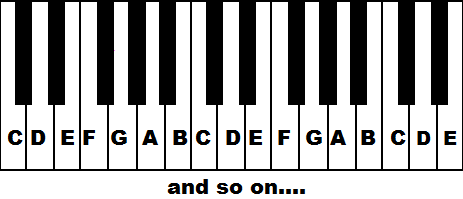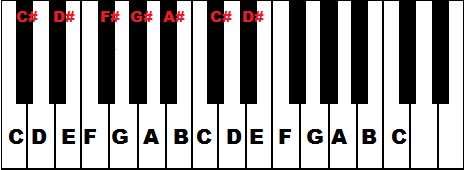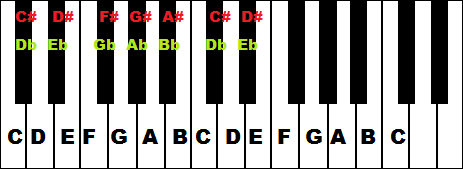So anyway, the musical alphabet is relatively simple. Do you know the English alphabet? You know, A though Z? Congrats! You already know over half of the musical alphabet (in terms of actual pitches. I'll explain that in a bit). The musical alphabet uses the following letters:
A B C D E F G
Simple, no? Let's take a look at that on the piano:

As you can see, once you get to G, you don't move up to H, nor do you start moving backwards. You simple go back to A. Because of this, think of these 7 notes of the musical alphabet more circularly rather than linearly. B is higher than A and lower than C. F is higher than E and lower than G. And G is higher than F, but lower than the next A. Two notes with the same name (e.g., two C's) but located at different places on the piano are said to be in different octaves.
Try this on a piano (if you don't have a piano or keyboard near you, use this). Play a few random notes on the piano. Take note of how different they sound. Now play the same note in different octaves (e.g., play an F, then play another F in a different spot). Even though one is higher than the other, the two sound pretty similar, don't they? That's what an octave essentially is.

**Scientifically/mathematically/nerdily speaking, if note X is an octave above note Y, then the frequency of note X is twice that of note Y (which means that the frequency of note Y is half that of note X). Remember, notes are just sound waves, which means that molecules in the air are vibrating at a certain rate. If I've lost you, then don't worry about it. It's not important for our purposes.
Now that you've got a hang of the initial 7 notes, let's figure out what those black keys are:

Ignoring the immaculate precision of MS Paint placing the notes on the keys, notice those strange symbols. What does that "#" sign mean? "C number? F number?"
'#' means 'sharp.' The black key immediately to the right of C is C#, to the right of D is D#, and so on. As you can probably guess, C# is sonically between C and D, hence the location of the black keys on the piano.
But wait! There's more!!

Oh great, now there's uppercase AND lowercase B's? Don't worry, the lowercase 'b' on the black keys means "flat." Whereas a sharp sign (#) means to raise the pitch by a half-step, a flat sign (b) means to lower the pitch of a note by half a step.
WHICH MEANS that 'C#' is the same thing as 'Db' (from a practical standpoint, not from a music theorist's perspective. We'll only worry about the practical).
"Hold on!" says you. "I see a flaw in your little theory. There's no black key between E and F, nor is there one between B and C! Explain that!!"
Well spotted, my young Padawan. Unfortunately for us, the musical deities at be had to make things rather complicated for us. The distance between any two consecutive notes on a piano (do NOT count two white keys as consecutive if there's a black key between them. Duh) is half-step, also called a semitone. Which means that the distance between two white keys is usually two semitones/two half-steps/one whole step. But the distance between E and F, as well as the distance between B and C, is only one semitone.

Whoops! Time to run to class! That's all for today. More to come eventually!

No comments:
Post a Comment